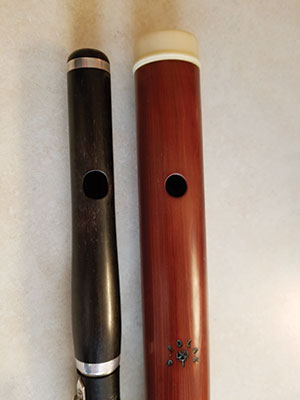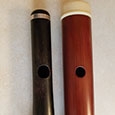When I was an undergraduate first discovering the joys of early music, new music, and auxiliary flutes, one of my professors urged me to focus in on a narrow area of specialization sooner rather than later. I resisted because I could not imagine giving up any of the instruments or styles of music that I loved. I am now decidedly mid-career and still cannot fathom giving up any of my instruments. While specialization might seem like the most direct route to the highest skill level on an instrument, experience on another instrument – or several – can yield insight and new perspectives.
The overlap between Baroque flute and piccolo is an especially interesting one because, at first blush, the main thing they seem to have in common is the ability to highlight all of the flaws in one’s playing. However, there are a surprising number of concrete ways that piccolo playing can be improved by an understanding of historical flutes and cultivation of some basic similarities of approach.

Air
Baroque flute and piccolo both have smaller apertures than modern flute, as well as narrower, tapered bores. Each requires its own kind of delicacy of approach, and can easily be overwhelmed with too much air, or by playing with excessive air pressure. Piccolo generally needs less vibrato than flute, and Baroque flute is customarily played without breath vibrato at all. In both cases, this can take vibrato off the table as a means of obfuscating pitch or masking other flaws in the sound.
Approaching the piccolo as an extension of the flute can sometimes lead people to play as though they are in the extreme high register of the flute, while they are actually in the middle of the piccolo’s range. It can result in entirely too much air pressure, and reactionary tension in the embouchure from holding back against that pressure. It is also easy for the upper torso and throat to lock up when playing piccolo, in part because of the closer proximity of the arms to the rib cage, and an attendant tendency to pull the arms or tuck the elbows against the ribs. All of this tension and pressure can lead to a lot of cracked attacks, and raspberries when players try to taper the end of a note. Baroque flutists often speak of trying to make the instrument ring, rather than choking off the resonance by forcing too much air.
One of the ideas I have found most useful in cultivating a more beautiful tone on any flute came from Baroque flutist Claire Guimond. She advocates approaching long tones with a goal of finding the best possible “airing” for each note (as opposed to merely the correct fingering). This idea is also helpful for finding the level of air pressure where the piccolo responds better, rather than forcing too much air into that tiny instrument. A helpful mindset for doubling in general is to try to deal with each instrument on its own terms and pay attention to what it seems to need from you. Instruments will generally let you know whether what you are doing is working by how they respond.
Pitch
Broadly speaking, when playing either piccolo or Baroque flute, players must take more responsibility for accurate placement of pitch. Good intonation comes from acceptance of this, rather than regarding it as a problem with the instrument itself. Your playing on both instruments will benefit from a cheerful assumption that the instrument is not fundamentally flawed. (After all, nobody argues that the violin is fundamentally flawed or horribly retrograde for not having frets.)
Recognize also that your perception is skewed by the instrument to which you are most accustomed. For example, if you have played the same flute for many years, you may be barely aware of the pitch adjustments you are likely making all the time. (Altern-atively, you may be playing out of tune much of the time in a way that is so familiar that it sounds correct to your ear.) Are the second- and third-octave Ds really that much worse on your piccolo, or are they just in a different place than where they happen to lie on your flute? This itself is a benefit of doubling. Playing the same instrument all the time can leave you with blind spots in your listening and perception.
Tuning and Temperament
Different systems of tuning and temperament are standard topics of study for historical flutists, but many modern instrumentalists know little about it. In equal temperament (what you have with an electronic tuner or synthesizer), the octave is divided into twelve equal semitones. Unfortunately, this means that all of the other intervals within that octave are bit out of tune, by varying degrees. An acoustically pure perfect fifth, for example, is a little bit wider than the fifth produced by equal temperament. A similarly beatless major third is considerably narrower than it appears in equal temperament. This tuning system does not result in well-tuned chords, but it has come to be regarded as a necessary evil for modern keyboard instruments, though good piano tuners tweak the tuning to make it sound better. This is one of the reasons why an electronic tuner has only limited usefulness.
Just intonation is a system that uses intervals tuned according to simple mathematical ratios, producing pure beatless intervals, but it results in scales that are so uneven that they sound odd to modern ears. In orchestras and bands, where pitch is flexible, it is impractical to try to employ this tuning system (even though some people claim that they do). A truly beatless major third, for example, is so much flatter – about 14 cents – than an equal tempered major third, most modern conductors would find it objectionable. In addition, music rarely moves slowly enough for this to be achievable. What flutists can do, however, even when tuning intervals against a piano, is to temper – or adjust – the pitch to be better in tune with the surrounding harmony. This relies on an understanding of the harmonic underpinning and how to adjust a note based on your role within the chord.
The principles of tuning and temperament are especially important for piccolo players because of the physics of playing in a higher octave than everyone else. Stephanie Mortimore, Principal Piccolo of the Metropolitan Opera Orchestra, has written an excellent article on some of the particular challenges of piccolo tuning (further information on page 31).
Even though piccolo players dwell in a higher octave, they are not necessarily sharp most of the time, as some assume. More often frightened or tentative piccoloists play flat, and it can be easy to get caught in an intonational shame spiral, where a player is spooked by a pitch problem, gets softer in the wrong way, backs off on the support, and goes even flatter. Then the intonation problem makes the piccolo stick out even more. That flatness is especially problematic because an interval that is too narrow sounds more offensive than one that is too wide (one of the reasons why trill keys are designed to produce slightly wide intervals). Therefore, when you are unsure of your pitch while playing the highest note in a chord, it is better to err a little on the high side, without overdoing it. Charlie DeLaney, former flute professor at Florida State University, used to joke, “It’s always better to be sharp than out of tune.”
Practicing various intervals over a drone will improve your ability to make real-time adjustments and will train you to be able to tune according to what you hear, rather than according to what you see on the dial of a tuner. A good regimen is to begin with a unison, then move systematically through other intervals above the drone pitch: octave, perfect fifth (widening slightly), perfect fourth (narrowing slightly), major third (narrowing considerably), etc. Piccolo players should also practice tuning intervals several octaves above the drone, because they are so often in a completely different octave from everyone, making all of this even trickier. Doing this without vibrato will allow you to hear the beats that occur when an interval is out of tune.
This is another case where piccolo players can learn from players of other instruments. Brass players often play chorale-like passages, and many prominent horn players create comprehensive charts to illustrate exactly how many cents a pitch should be raised or lowered in nearly every conceivable harmonic context. Baroque flutist Rachel Brown advocates practicing lip bends to the point where you can bend each pitch over the interval of a third. Once you have the ability to place a pitch virtually anywhere, it becomes purely a matter of knowing where to put it in a particular situation.
Alternate Fingerings
As a young player, I was often scolded for using middle-finger F sharps, and was slightly ashamed of the fake fingerings I used when my teacher was not looking. My experiences with historical flutes completely expanded my thinking about alternative fingerings.
There was no single standard flute fingering chart in the Baroque Period, and most charts prescribed different fingerings for what modern players would consider to be enharmonic equivalents. The fingering for G flat is higher in pitch than an F sharp, for example. This has to do with the aforementioned likely function within the chord: In G major, F sharp often functions as the major third of the dominant, D major. Therefore, it needs to be lower in pitch.
Margaret Neuhaus’s Baroque Flute Fingering Book compiles the fingerings from twenty-one different charts, in many cases offering eight to twelve different fingering options for a single note. I learned to treat these many options as useful and viable alternatives, and I believe that the correct fingering is the one that is most suited to the occasion or works best in a particular context. Baroque flutists become accustomed to learning a battery of options for certain notes, sometimes for dynamic or pitch adjustments. Often they opt for a series of consecutive notes that then can all be lipped or adjusted in the same direction, rather than having to adjust back and forth between sharp and flat fingerings. The idea that there is one correct primary fingering for each note – one that is true and morally superior to all others – becomes, quite frankly, quaint.
My piccolo playing has benefited greatly from this approach, and I have accumulated a small mental stockpile of useful alternative fingerings. There are nearly always trade-offs, so the use of an alternative fingering depends on context. Several good fingerings that allow certain upper-register notes to be played more softly also tend to be sharp and have to be adjusted downward. Sometimes, on either instrument, a fingering that might give you the overall best result for the given circumstance is not necessarily the easiest, so one gets accustomed to awkward combinations. Jack Wellbaum’s and Walfrid Kujala’s excerpt books include information about essential alternative fingerings for piccolo, along with excellent illustrations of context, pros, and cons.
Doubling in General
If these historical sources of information and understanding are useful on piccolo (the magnifying mirror of the flute family), then they are surely also beneficial for flute playing in general. Besides these concrete examples, there are other more general advantages to instrumental cross-training that include a refreshed perspective, a way to break out of auto-pilot, increased physical and mental flexibility, and heightened musical empathy (from experiences like playing the continuo line on bass recorder in a performance of someone else’s solo sonata).
One of the things I love most is the variety in my days, and how I always have something new, challenging, and engaging on which to work. There are times when I do wonder whether it would be easier to narrow my focus. Then again, I was recently given a beautiful 1830s six-keyed flute pitched at A=430, and I am just starting to get to the point where I don’t have to think so hard about the fingerings!
Further Reading
Ross Duffin, How Equal Temperament Ruined Harmony (and Why You Should Care). W.W. Norton & Company, 2008.
Walfrid Kujala, Orchestral Techniques for Flute and Piccolo: An Audition Guide; An Inside Look at Symphonic Performance Traditions. Progress Press, 2006.
Stephanie Mortimore, Taming the Beast: Stephanie Mortimore Revolutionizes Your Piccolo Intonation. Article on the Metropolitan Opera Orchestra’s website, 2014: www.metorchestramusicians.org/
blog/2014/4/14/taming-the-
Margaret Neuhaus, The Baroque Flute Fingering Book: A Comprehensive Guide to Fingerings for the One-Keyed Flute, Including Trills, Flattements, and Battements, based on Original Sources from the Eighteenth and Nineteenth Centuries. Flute Studio Press, 1986. (Out of print, but available through Inter-Library Loan.)
Jack Wellbaum, Orchestral Excerpts for Piccolo. Theodore Presser, 1999.






